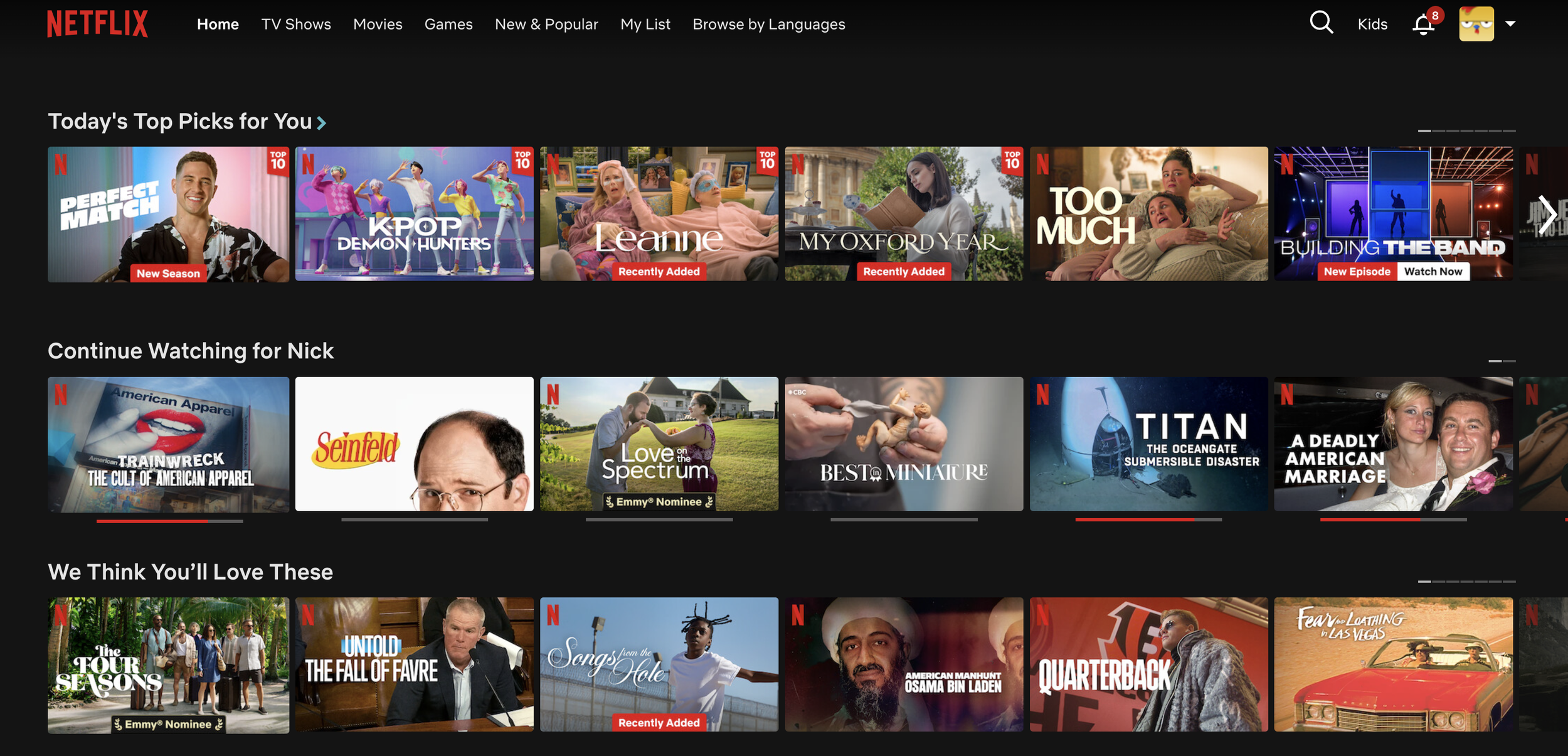IP 5 - Algorithms
CONTENT PRIORITIZATION
In our context, content prioritization is the process by which search engines and digital platforms “decide” which content to highlight, make the most visible, or display to the user first. This often dictates what the users will see and propositions it as the most useful, relevant, and even credible information. As evident by the work of Noble (2018) and others, this process is far from neutral. Let’s look at some examples of where we might see it:

My Spotify "daylist" which uses content prioritization and algorithms to sort and push music to me.

My Netflix account which has "Today's Top Picks" just for me and "We Think You'll Love These" sections that are based on my viewing history and other factors.

A Google search for "best gyms Toronto" on Aug 15th reveals the top results that were pushed to me.
how does it work?
Content prioritization will work differently across platforms. However, at its core, the process relies on some commonalities:
Collection of large data sets
Labelling of large data sets
Algorithmic analysis of patterns within the data sets
A prediction or prioritization of these patterns based on the user input and the relatability
We can look at Google’s explanation of their page rankings for an example of “how” they prioritize content in response to our searches. I use quotations around “how” because although it is widely accepted that Google uses crawling, indexing, PageRank, BERT, and RankBrain, there is still some secrecy that exists around exactly how any given result is displayed or pushed to a user.
Here is Google’s own explanation of how their search results and page ranking work.
Spotify offers very little public information about how they are using artificial intelligence to power their “daylists” and prioritize content individually for each of their users. Similarly, Netflix offers a very vague explanation of their content prioritization or recommendations. It is very clear that content prioritization has had major impacts on the film and tv industry and even culture in general. We can almost feel this as we passively consume content across any social media platform - what we see is never by accident and almost never by choice either.
PAGERANK AND ME
Google is my preferred search engine, so I am constantly (both personally and professionally) influenced by the choices it presents when I search online. Personally, this might shape the design decisions I make or the materials I purchase during home renovations. The same influence extends to other algorithm-driven platforms like Instagram or Pinterest, which also prioritize content in ways that guide my inspiration and choices.
Professionally, content prioritization can push specific resources my way. Higher-ranked teaching tools, edtech platforms, or grant opportunities may directly shape what I bring into my classroom. Even a simple search like “science field trips Toronto” is subject to PageRank’s influence. This awareness is equally important when designing learning opportunities for students. If students are left to search independently, it is pretty fair to assume many will rely heavily on the first few results, treating them as the most credible sources. This sort of “top-result reliance” can narrow the variety of perspectives and resources they consume, potentially excluding valuable but lower-ranked content. As an educator, this returns the responsibility back to me. I need to model critical evaluation and deliberately seek out diverse sources to reduce reproducing the inequalities and biases that exist within the search algorithms. This isn’t always easy.
NEW THOUGHTS
From my searching, this assignment has existed since at least 2022. In the last three years, the concept of content prioritization has changed dramatically, driven by the public access to LLMs and the adoption of “artificial intelligence” into almost every search engine or query-based application (e.g., Siri). Google search now answers your questions at the top of the page. Siri now uses ChatGPT to create succinct answers to questions. Yet, we have even less transparency into where these answers come from. Partnerships, like Siri and OpenAI leave a question about who has chosen what is presented to us first. The need for succinct results compresses sources and information into these untangleable outputs, and even hides what was excluded from its search. As this evolves, what is next? Will we start seeing a monetization of AI-driven results? In some ways it already has, as tiered access to programs like ChatGPT, Gemini, or even Consensus affect the depth of responses users get. Ironically, this IP exploration and “search” has left me with more questions than answers. Here are a couple new considerations:
How might the monetization of post-LLM integrated content prioritization impact our society, especially in vulnerable spaces like elementary education?
How do we balance the convenience afforded by new algorithmic-driven tools with the need to recognize and reduce the dangers presented by their reinforcement of bias and discrimination embedded within the models?
SOURCES:
Google. (n.d.). How Google Search works: Ranking results. Retrieved August, 2025, from https://www.google.com/intl/en_us/search/howsearchworks/how-search-works/ranking-results/
Google. (n.d.). How Search works. Retrieved August, 2025, from https://developers.google.com/search/docs/fundamentals/how-search-works#introducing-the-three-stages-of-google-search
Harvard Division of Continuing Education. (2023, August 9). AI will shape the future of marketing. https://professional.dce.harvard.edu/blog/ai-will-shape-the-future-of-marketing/
Noble, S. U. (2018). Algorithms of oppression: How search engines reinforce racism. NYU Press.
Sullivan, M. (2024, January 17). What social media algorithms actually do, and how to avoid getting played. NPR. https://www.npr.org/2024/01/17/1224955473/social-media-algorithm-filterworld
Vincent, A. (2024, January 24). Can A.I. make your playlist better?. The New York Times. https://www.nytimes.com/2024/01/24/style/ai-spotify-music-playlist-algorithm.html

